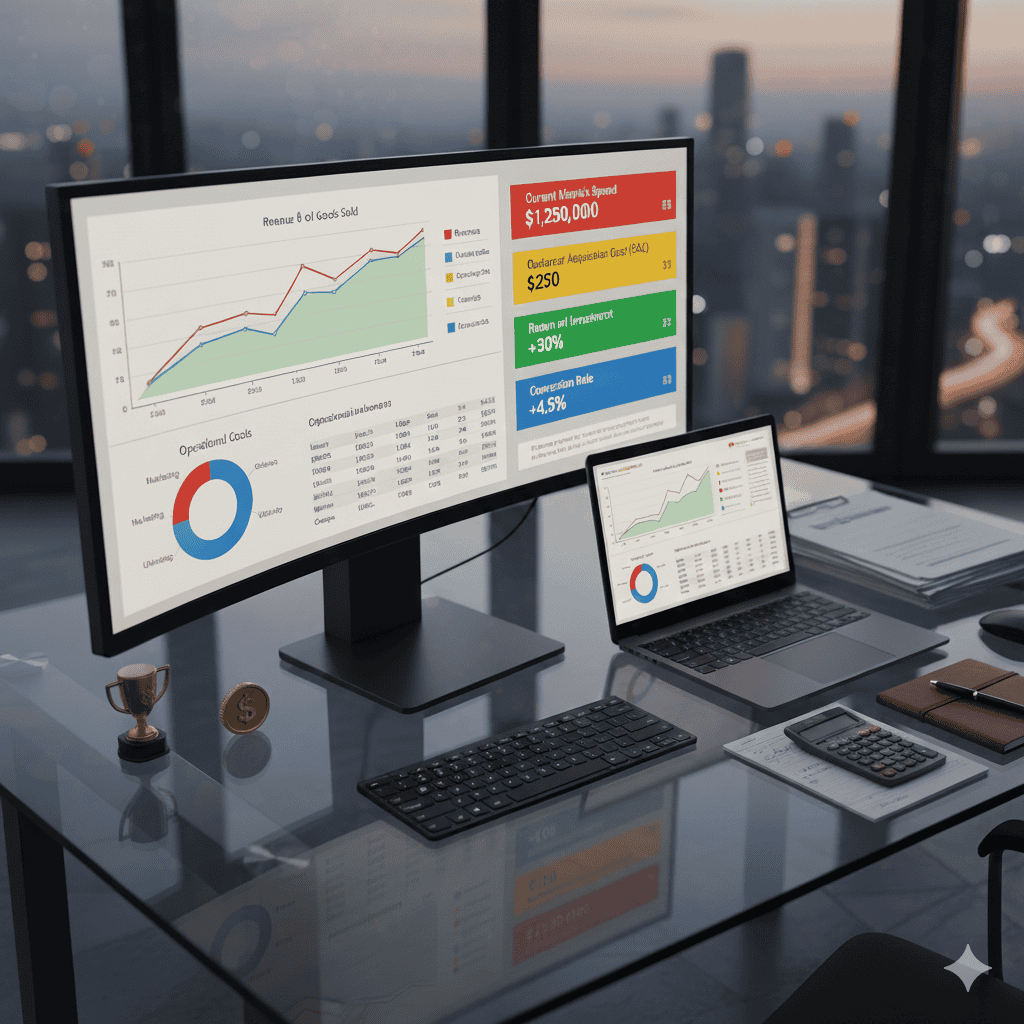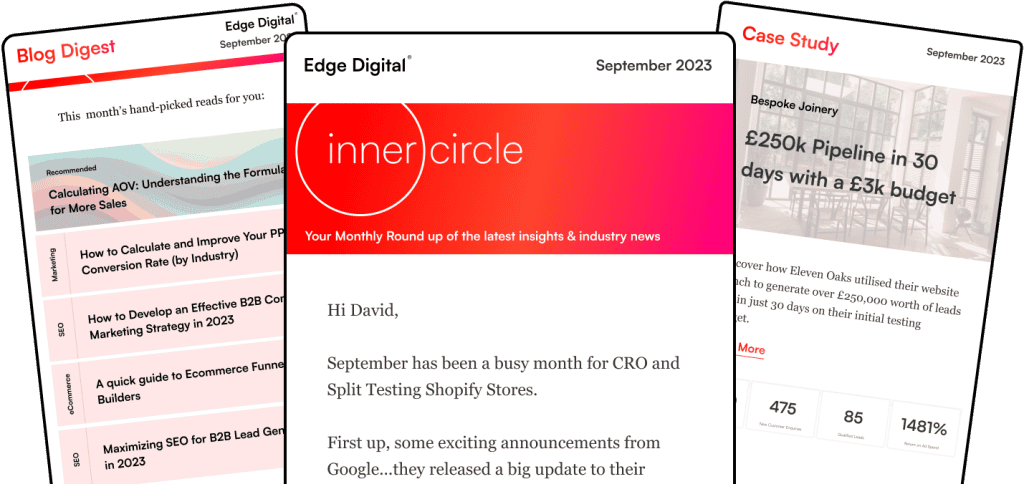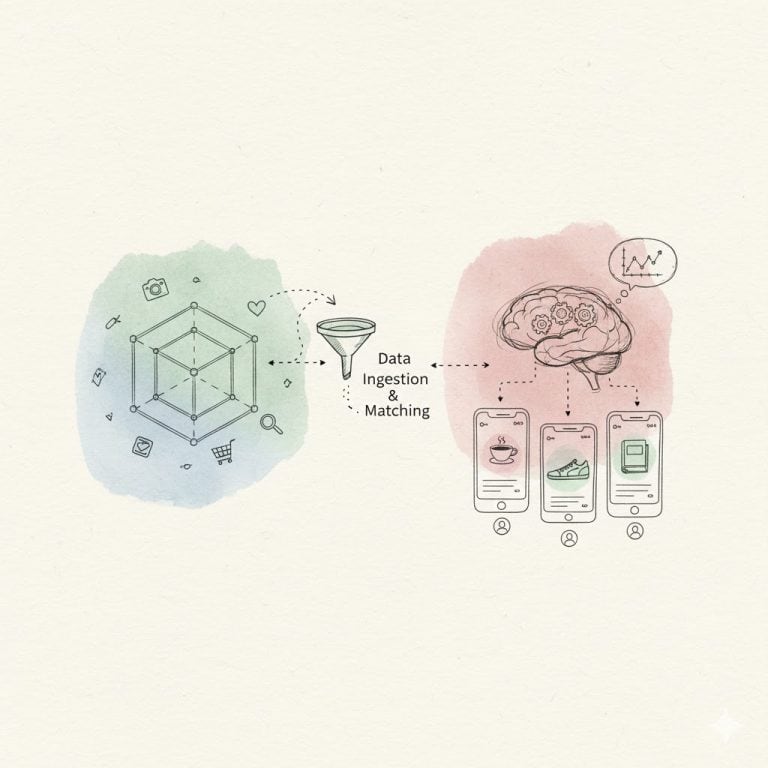Planning your online advertising budget without knowing what costs to expect is kind of like driving blindfolded. Most businesses deal with unpredictable ad spend that can spiral out of control or lead to disappointing results. In this blog we will look at ways in which you can forecast online ad costs and projections.

Effective ad cost forecasting mixes your historical data with current market trends to predict future spend within about 10-20% accuracy. This means looking at your past campaign metrics, understanding seasonal patterns, and factoring in competition across platforms.
Google Ads costs range from £1-£5 per click for most industries. On social media, platforms like Facebook are usually cheaper, at around £0.50-£2 per click.
Forecasting helps you spread your budget wisely, avoid overspending, and maximise your return. Whether you’re planning for the next quarter or launching a new campaign, knowing how to estimate ad costs gives you confidence to make smarter marketing moves.
Key Takeaways
- Historical campaign data and market trends can predict costs with 10-20% accuracy.
- Every platform has its own cost structure, so you’ll need different approaches for each.
- Keep an eye on your forecasts and adjust as you go to stay on track.
Understanding Online Ad Cost Forecasting
Ad cost forecasting is all about predicting how much you’ll spend on digital advertising and what you’ll get back. Good forecasts help you set realistic budgets and make smarter decisions across different platforms.
What Is Ad Cost Forecasting?
Ad cost forecasting is estimating future ad expenses using your past data, market trends, and campaign goals. It lets you get a sense of costs before you even start.
You’ll estimate daily or monthly spend, predict costs per click, conversion, or impression, and calculate expected returns.
Advanced algorithms can process huge amounts of data to forecast costs more accurately. Machine learning models use your past results to improve future predictions.
Most forecasting tools look at things like seasonal trends, competitor activity, and audience behaviour. Platform-specific stuff like auction dynamics and algorithm updates also matter.
Why Accurate Ad Forecasts Matter
Good forecasts stop you from overspending and help you put your budget where it matters. Without them, it’s easy to waste money on campaigns that just don’t work.
Understanding market conditions lets you adjust your ad budget when things change, like shifts in consumer demand or economic ups and downs.
Planning for seasonal changes is huge. During busy times like holidays, ad costs usually go up because everyone’s competing for attention.
Forecasting also makes it easier to measure ROI. When you know your expected costs, you can see if your campaigns are actually hitting the mark and tweak things quickly if needed.
Key Terminology: CPC, CPA, and ROAS
Cost Per Click (CPC) is what you pay every time someone clicks your ad. This number changes a lot depending on the platform and industry.
Cost Per Acquisition (CPA) is how much you spend to get one customer or conversion. Just divide your total ad spend by the number of conversions.
Return on Ad Spend (ROAS) tells you how much revenue you get for every pound spent on ads. If your ROAS is 4:1, you’re making £4 for every £1 you spend.
Here’s how these metrics fit into forecasting:
- CPC helps you guess how many clicks you’ll get for your budget.
- CPA shows how many customers you’ll likely gain.
- ROAS gives you an idea of the revenue you can expect.
If your CPC is high but your CPA is still low, things might be working well. And a strong ROAS can justify spending more on successful campaigns.
Analysing Historical Data and Market Trends
Looking at your past campaigns gives you a solid base for forecasting, while market trends show you what might change in the future. Competitor analysis helps keep your predictions realistic.
Leveraging Historical Campaign Data
Your old campaign data is key for forecasting. Aim for at least three months’ worth to spot actual trends.
Metrics to pay attention to:
- Cost per click (CPC) trends
- Conversion rates by campaign
- Click-through rates (CTR) over time
- Daily and monthly spend patterns
Check your data for campaigns that had steady costs and good returns. See which keywords always perform and how your costs changed during different times.
Campaign results can vary a lot depending on ad format and placement. For example, desktop ads might cost more or less than mobile ones, and your historical data will show that.
Identifying Seasonal and Market Trends
Seasons can really impact your ad costs. Many businesses pay more during peak times.
Common seasonal trends:
- Higher costs during holiday shopping seasons
- Fitness brands see more competition in January
- B2B costs often drop in summer
- Back-to-school spikes for education
Look at year-over-year data to spot these patterns. Compare the same months in different years to see what’s normal for your business.
Market events also matter. Things like economic changes or competitor product launches can shift ad prices fast.
Trend analysis helps you spot these shifts by looking at industry data alongside your own numbers.
Benchmarking Against Competitors
Checking out your competitors gives you useful benchmarks. You want to know how you stack up in your industry.
Industry benchmarks help you see if your cost predictions are realistic. If your forecasted costs are way lower than your competitors, you might need to adjust.
Benchmark areas:
- Average CPC for your industry
- Typical conversion rates for similar businesses
- Seasonal spend patterns in your sector
- Market share among top advertisers
Tools like auction insights can show how often you’re competing with certain advertisers. This tells you how intense the competition is for your keywords.
When competitors bump up their spending, your costs usually go up too. Keep an eye on their big promo periods or product launches—they can drive up prices for everyone.
Choosing Forecasting Methods and Tools

You’ve got a few ways to forecast ad costs: manual calculations, built-in platform tools, or advanced AI systems. Each has its pros and cons when it comes to accuracy and automation.
Manual Forecasting Techniques
Manual forecasting means you’re in control, using your own calculations and past data. Start by pulling metrics like CPC, conversion rates, and total spend from your ad accounts.
A basic method is to average past costs and multiply expected clicks by your historical CPC to estimate future spend. You can also set your budget as a percentage of projected sales.
Key manual calculations:
- Average CPC × Estimated clicks = Needed budget
- Historical cost-per-conversion × Target conversions = Required spend
- Budget as a percentage of revenue (usually 5-15%)
Manual methods are great for stable campaigns but can miss big changes like seasonality or new market trends. You’ll need to update your numbers regularly.
It takes some spreadsheet skills and time, but it helps you really understand what’s driving your costs.
Using Digital Ad Platform Forecasts
Most ad platforms offer built-in forecasting tools that use your past data. Google Ads Performance Planner and similar tools estimate results based on your targeting and budget.
Meta Ads Manager has Campaign Budget Optimisation and delivery estimates, predicting reach and performance automatically.
Platform forecasts factor in:
- Auction competition
- Seasonal trends from platform-wide data
- Audience size and engagement
- Your historical account performance
These tools update predictions as you tweak your targeting, budget, or creative. You can test scenarios before launching.
Benefits:
- Real-time data
- Free with your ad account
- Insights into platform algorithms
But remember, these tools only look at their own platform and might miss cross-platform competition or outside market changes.
AI-Driven Forecasting Solutions
AI-powered forecasting tools can crunch tons of data for more accurate predictions. They analyse your history, seasonal patterns, and live market conditions all at once.
Tools like AdAmigo.ai give automated budget recommendations, especially for Meta ads. They track things like click-through rates, CPA, and audience behaviour.
AI forecasting perks:
- Deep learning predictions, not just averages
- Automated budget tweaks based on goals
- Optimisation across multiple campaigns
- Dynamic seasonal planning
These tools keep learning from your new data and can spot trends you might miss. They’re especially handy if you’re running lots of campaigns or have a big ad budget.
AI tools usually cost £75-£400 a month, depending on your spend. They handle the complex maths so you can focus on strategy and creative ideas.
Core Metrics for Cost Prediction

To forecast ad costs well, you need to know four key metrics that shape your budget. These give you a full picture of campaign expenses and possible returns.
Estimating Click-Through Rate (CTR) and Conversion Rate
Click-through rate (CTR) is how many people click your ad after seeing it. For search campaigns, the industry average is 2-5%, but your actual rate depends on your ad quality and targeting.
Use your past campaigns to estimate CTR. If you’re starting from scratch, play it safe and use 1-3% until you have real data.
Conversion rate is the percentage of clicks that turn into sales or leads. E-commerce sites usually see 2-4% conversion rates, while lead generation campaigns can hit 5-15%.
To calculate conversion rate, divide total conversions by total clicks. For example, 100 clicks and 3 conversions means a 3% conversion rate.
What affects these rates:
- How relevant and high-quality your ads are
- Landing page experience
- How well you target your audience
- Competition levels
- Timing and seasonality
Calculating Cost per Click (CPC)
Cost per click measures the amount paid each time someone clicks your advertisement. This metric varies a lot across industries and keywords.
Google Keyword Planner gives you CPC estimates for specific terms. But forecasting tools usually show higher costs if you don’t have ROAS or cost-per-acquisition targets.
CPC depends on several auction factors:
- Keyword competition
- Quality Score
Bid strategy and ad position also play a role.
Competitive keywords in finance or insurance can cost £20-50 per click. Less competitive terms might only cost £0.50-2.00 per click.
Google confirmed during antitrust trials that it inflates CPCs over time. It’s smart to budget for 5-15% annual CPC increases if you’re planning long-term campaigns.
Determining Cost per Acquisition (CPA)
Cost-per-acquisition tells you how much you spend to get one customer or lead. To figure it out, just divide your total ad spend by your total number of conversions.
For example, if you spend £1,000 and get 25 conversions, your CPA is £40. This metric helps you see if your campaigns are profitable and where your budget should go.
Target CPA should align with customer lifetime value. If a customer is worth £200, spending £50 to acquire them still leaves you with a good margin.
Performance forecasting tools project CPA alongside other key metrics. Use these to set realistic acquisition targets.
Different campaign types have different CPAs. Search campaigns usually cost less per acquisition than display or social campaigns, since the intent is higher.
Predicting Conversions and Revenue
Revenue forecasting is all about using your other metrics to guess how much you’ll make. Multiply projected clicks by your conversion rate to estimate total conversions.
Accurate forecasting uses real data to predict return on investment. Historical performance is your best bet for solid projections.
Calculate projected revenue using this formula: Clicks × Conversion Rate × Average Order Value = Projected Revenue
So, if you expect 1,000 clicks, a 3% conversion rate, and a £75 average order value, you should see about £2,250 in revenue.
Google’s Forecast tool analyses historical search data, bid competition, and traffic patterns. This helps you estimate conversions for new campaigns.
Seasonal changes matter too. Retail campaigns often do better during holidays, while B2B campaigns might slow down in the summer.
Ad Budget Planning and Allocation
Good ad budget planning starts with setting clear advertising goals that match your business objectives. You’ll want to split funds across multiple campaigns to get the most out of your budget.
Setting Advertising Goals
Before you spend a penny, it’s important to know what you want your ads to achieve. Your goals will shape how much you spend and where you put your resources.
Common goals are increasing brand awareness, generating leads, driving sales, or getting more website traffic. Each one needs a different budget and approach.
Primary Goal Types:
- Brand Awareness: Focus on reach and impressions
- Lead Generation: Emphasise cost per lead metrics
- Sales Conversion: Prioritise return on ad spend
- Traffic Growth: Target cost per click optimisation
It’s smart to define your marketing and business objectives before setting a budget. That way, every pound you spend is working toward what you actually want.
Budgets vary depending on goals. Brand awareness usually needs more money for a wide reach, while lead generation can work with smaller, targeted budgets.
Allocating Budget Across Campaigns
Don’t put all your eggs in one basket. It’s best to split your budget across different campaigns and channels to get better results.
Budget allocation refers to how we distribute our digital marketing budget across channels like paid search, social media, display, and video.
Allocation Strategy Framework:
- High-performing campaigns: 40-50% of budget
- Testing new campaigns: 20-30% of budget
- Seasonal campaigns: 15-20% of budget
- Brand campaigns: 10-15% of budget
Platforms like Meta and Google have campaign budget optimisation tools to help you automatically distribute your budget based on what’s working.
Check in on your campaigns weekly. Move money to what’s working and cut back on what isn’t.
Incorporating Performance Goals into Forecasts
Performance goals should be baked into your budget forecasts from the start. Set targets like cost per acquisition, return on ad spend, or click-through rates before you launch anything.
Work backwards from your targets to set your budget. If you want 100 leads at £20 each, you’ll need £2,000 for that campaign.
Key Performance Metrics to Forecast:
- Cost per click (CPC)
- Cost per acquisition (CPA)
- Return on ad spend (ROAS)
- Click-through rate (CTR)
Budget forecasting for PPC helps you estimate results before adding new channels. Make sure your projected numbers line up with your goals before you launch.
Update your forecasts regularly with real campaign data. The more you know from past performance, the better you can plan for the future.
Optimising and Refining Forecasts
Keeping your forecasts accurate means watching real-time performance data and making changes if things aren’t going as planned. You’ll want a system for moving budget around and improving your approach as you learn.
Adjusting for Real-Time Performance
Watching your campaigns in real time helps you spot any big differences from your forecasts right away. Track key metrics like CPC, conversion rates, and click-through rates to see how you’re doing.
If a campaign is doing better than expected, bump up the budget. If it’s not, cut back or tweak your targeting.
Critical metrics to monitor:
- Actual vs. forecasted CPC – shows market competition changes
- Conversion rate variance – shows audience engagement shifts
- Daily spend pacing – reveals budget allocation issues
Set up alerts if performance swings by more than 15% from your forecast. This way, you’ll catch important changes quickly.
AI-powered budget forecasting tools can help by automatically adjusting spend based on real-time results.
Responding to Budget Variance
If your actual spend is way off from your forecast, it’s time to dig in and fix it fast.
Common issues:
- Overspending – usually from more competition or broader targeting
- Underspending – can be from too small an audience or tight targeting
- Uneven distribution – happens when budgets aren’t spread well across ad sets
If you’re overspending by 20% or more, check out what’s happening with auctions and competitor activity. Markets can change fast.
If you’re underspending, try loosening up your targeting or raising your bids. Campaign budget optimisation tools can help move money from weak campaigns to strong ones.
Set clear rules for budget changes:
| Variance Level | Action Required | Timeline |
|---|---|---|
| ±10% | Monitor closely | Daily review |
| ±20% | Adjust targeting | Within 6 hours |
| ±30% | Pause/reallocate | Immediate |
Iterative Improvement Over Time
Your forecasts get better the more you learn from past campaigns. Look at what actually happened versus what you expected.
After 6-12 months, you’ll start to see seasonal patterns. Holidays, industry events, and the economy all make a difference.
Do a monthly review to see where your forecasts were off. This helps you spot trends and improve your predictions.
Key improvement areas:
- Audience behaviour changes over time
- Market saturation affects costs differently
- Creative fatigue impacts performance predictably
Advanced forecasting techniques like machine learning can find patterns in your data that you might miss. These can give you more accurate predictions.
Don’t forget that ad platforms change their algorithms sometimes. Adding a 15-25% buffer to your forecasts can help you stay on track when things shift unexpectedly.
Advanced Considerations for Reliable Forecasts
Getting your ad forecasts right means understanding your audience and being ready for surprises. It’s also about having good ways to measure success and handle uncertainty in digital advertising.
Factoring in Audience Behaviour
Knowing how your audience acts during different seasons and events is key for good forecasting. People behave differently during sales, holidays, or economic shifts.
Seasonal Behaviour Patterns:
- Black Friday can boost click-through rates by 300-500%
- B2B audiences usually drop activity by 40% in the summer
- Healthcare searches can spike 200% during flu season
Check your historical data for these trends. Look at year-over-year changes in conversion rates, order values, and how long people take to buy.
Device and Platform Preferences: Mobile users usually convert 20% less than desktop users, but they make up 60% of ad clicks. This makes forecasting PPC tricky.
Keep an eye on:
- Mobile vs desktop conversion paths
- Social media vs search engine audiences
- First-time vs returning visitor patterns
Age matters too. People aged 25-34 often have the highest lifetime value, but they take longer to make a decision.
Managing Risk and Uncertainty
Digital advertising is full of surprises. Forecasts can be off by 20-40% in just a few weeks, so it’s smart to build in some wiggle room.
Market Volatility Factors:
- Competitor budget changes can push CPCs up by 15-30% overnight
- Algorithm updates affect about 10-15% of campaigns every quarter
- Economic changes can shift consumer spending fast
Google Ads forecasting accuracy varies widely for individual campaigns. Treat forecasts as a guide, not a guarantee.
Risk Management Strategies:
| Risk Level | Budget Buffer | Review Frequency |
|---|---|---|
| Low | 10-15% | Monthly |
| Medium | 20-25% | Bi-weekly |
| High | 30-40% | Weekly |
Set spending alerts at 70% and 90% of your monthly budgets. This helps you avoid overspending if things change suddenly.
Scenario Planning: Build three forecast scenarios—conservative, realistic, and aggressive. For the conservative one, assume costs are 15% higher and conversion rates are 10% lower than your historical averages.
Evaluating Return on Investment
Getting a true picture of ROI means looking beyond just the basics. Consider customer lifetime value, attribution windows, and conversions that standard tracking might miss.
Advanced ROI Metrics:
- Customer Acquisition Cost (CAC) including all funnel costs
- Lifetime Value to CAC ratio should be 3:1 or better for growth
- Payback period for different audience segments
If you only count direct conversions, you might miss out on 20-40% of campaign value. Make sure to include view-throughs, assisted conversions, and brand lift.
Attribution Challenges: Most customers interact with 7-12 channels before buying. First-click and last-click models miss about 60% of the journey.
Go for data-driven attribution if you can. It’s usually more accurate than the standard models.
ROI Benchmarks by Channel:
| Channel | Average ROI | Payback Period |
|---|---|---|
| Search | 200-400% | 30-60 days |
| Display | 150-250% | 60-90 days |
| Social | 100-300% | 45-75 days |
Check ROI every month. If performance is off by more than 15% from your forecast, adjust your numbers so your plans stay relevant.
Frequently Asked Questions
Understanding the basics of online advertising cost forecasting helps you make smarter budget decisions. Here are some common questions that cover the most important parts of predicting and managing digital ad spend.
What are the primary factors that influence online advertising expenses?
Competition in your industry is a huge factor in ad costs. For example, legal services and insurance often pay £5-12 per click because there’s so much competition.
Your target audience also affects pricing. Targeting business executives on LinkedIn costs more than reaching general consumers on Facebook.
Ad quality and relevance matter too. Platforms like Google and Facebook reward high-quality, relevant ads with lower costs per click.
Seasonal timing can change your advertising costs. Busy shopping periods like Black Friday usually drive up prices across most platforms.
The ad format you pick impacts pricing. Video ads tend to cost more than text ads, but they often get better engagement.
How can historical data be leveraged to predict future advertising costs?
Look at your past cost-per-click data by month to spot seasonal patterns. Most businesses see 20-40% higher costs during Q4 holidays.
Track your quality scores over time. Improving ad relevance can reduce costs by 15-30% for many advertisers.
Check out competitor activity from previous years. Some industries have predictable busy seasons and cost spikes.
Calculate your average cost per conversion by quarter. This helps you plan budgets for similar campaigns in the future.
Watch how your audience targeting costs change over time. Narrower audience segments usually get pricier as more advertisers compete.
What methods are effective for estimating the return on investment for online ad spend?
Start by figuring out your customer lifetime value. This tells you how much you can spend to get a new customer and still make a profit.
Knowing your industry’s average cost-per-lead and cost-per-click helps set realistic ROI expectations. Conversion rates can vary a lot between industries.
Track every touchpoint in your customer journey. Measuring both offline and online interactions gives you a more accurate ROI.
Use attribution modelling to give credit to multiple ad interactions. Most people see several ads before deciding to buy.
Set up conversion tracking on all your platforms. Without it, your ROI numbers could be way off.
Could you explain the role of bidding strategies in managing online advertising budgets?
Automated bidding strategies help control your daily spend while optimising for your goals. Target cost-per-acquisition bidding keeps you from overspending on conversions.
Manual bidding gives you more control over your maximum costs. It works well if you know your profit margins and have solid conversion data.
Smart bidding uses machine learning to adjust bids in real-time. Google’s smart bidding can lower your cost-per-conversion compared to manual bidding.
Enhanced cost-per-click tweaks your manual bids automatically. It raises bids for likely conversions and lowers them for less promising clicks.
Bid adjustments let you spend more or less on certain audiences. For example, you might bid higher for mobile users if they convert better.
What tools or software are recommended for accurately projecting online advertising fees?
Google Keyword Planner gives cost estimates for search campaigns. You can see average cost-per-click ranges for your chosen keywords.
Facebook Ads Manager has reach and frequency tools to estimate costs based on your audience and campaign goals.
Third-party tools like SEMrush and Ahrefs show competitor ad spend estimates. This helps you compare your budget to similar businesses.
Google Analytics lets you track conversion costs across different channels. You can set up goal values to get accurate cost-per-conversion data.
Budget allocation tools help you split your spending across platforms. These tools optimise your budget based on each channel’s performance.
How does audience targeting impact the cost of online advertising campaigns?
Broader audiences usually cost less per click, but the conversion rates can be lower.
Narrow, specific audiences tend to cost more, but they often convert better.
On LinkedIn, targeting by job title and company size costs around £5-15 per click. On Facebook, it’s more like £0.50-2 per click.
Lookalike audiences, built from your best customers, can strike a nice balance between precision and cost.
Geographic targeting can really change your costs. Ads in big cities like London might cost 50-100% more than in smaller areas.
Interest-based targeting on social platforms can get pricey, especially if lots of advertisers are chasing the same interests.



